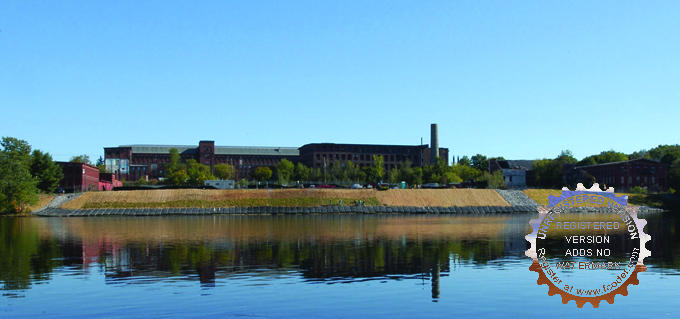An innovative public/private partnership launched by Northern Utilities, with MACTEC leading the environmental engineering project, is helping to revitalize the city of Lewiston.
Lewiston, in Androscoggin County, is the state's second largest city (pop. 40,000) and is located about 35 miles north of Portland. The city was settled in 1770 and officially incorporated in 1795.
Notable people from Lewiston include Bill Carrigan, manager of the 1916 world champion Boston Red Sox; Rick DiPietro, ice hockey goaltender for the New York Islanders and Team USA in the 2006 Winter Olympics in Turin; and Patrick Dempsey, one of the stars of the TV show Grey's Anatomy. In 1965, Muhammad Ali knocked out Sonny Liston in what's now known as the Androscoggin Bank Colisee.
Starting in the late 1950s, lower production costs elsewhere led to the closure of many of Lewiston's textile mills, which were the city's economic base and once produced a quarter of American textiles. Another city fixture, the Lewiston Gas Light Company, operated a manufactured gas plant (MGP) from 1854 to 1962. The site was subsequently decommissioned, and most of the gas plant structures demolished and removed or abandoned in place.
Today the property is the location of one of Northern Utilities' natural gas distribution regulator stations as well as a service corridor used for staging and storage associated with Northern's construction and maintenance work.
Environmental Issues
Extending 600 feet along the Androscoggin River entirely within the 100-year floodplain, the site had a severely eroded riverbank containing solidified coal tar and other MGP residuals, all from decades of former gas manufacturing operations. A potential public health hazard and environmental concern, the unsightly riverbank was the source of offensive odors that often impacted the nearby residential area.
Investigations identified underground coal tar at the riverbank in the form of what environmental scientists term a dense non-aqueous phase liquid (DNAPL). Heavier than water, the DNAPL had sunk into the subsurface to the top of the continuous clay layer forming the lower portion of the groundwater column, where it threatened to migrate to the river.
Designing Containment System
The remediation project spearheaded by MACTEC was conducted under the Maine Department of Environmental Protection's (DEP) Voluntary Response Action Program (VRAP). A containment system was designed to meet Northern Utilities's objectives:
* Create a public riverside park to support the Lewiston's Southern Gateway redevelopment project
* Eliminate odors
* Prevent exposure to the residuals
* Prevent migration of the residual wastes to the Androscoggin River
Site Challenges
Some of these included:
* Androscoggin River wetland boundaries and adjacent private property owners.
* Existing water, sewer, active gas utilities, and commuter traffic flows.
* Extensive best management practices for erosion controls were applied to stabilize excavations from ice and current scouring during flood stage river levels.
* Extensive coordination with owners of four private Androscoggin River hydro-projects was conducted to gauge river fluctuation during precipitation and high water events.
* Global stability analysis of soils and construction equipment was used to determine static and dynamic loading of slope fill and river sediment impacts to cofferdam stability.
*MACTEC's design specified that the contractor complete the trench installation and be conducting work on higher elevations at the top of the 20-foot high riverbank slope by mid-March 2007 when snow melt and resulting high water conditions inundated the collection trench location.
Innovative Techniques
A passive coal tar collection trench was engineered using the differences in specific gravity between the DNAPL and groundwater to induce the coal tar to enter the trench. To prevent contact with the residual wastes, erosion of the residuals into the river, and to control odors, a multi-layer cap system was designed for the steep embankment. The cap system consisted of a gas collection piping layer, geomembrane odor barrier, synthetic stormwater draining layer, and a topsoil-filled geocell stabilization layer.
The design incorporated a vapor collection system beneath a vegetative blanket anchored by a stone mattress to contain environmental contaminants, reduce erosion, and culminate in a safe and attractive public park for beneficial site re-use. All excavated waste materials were pre-treated on site and transported to an asphalt-blending facility for beneficial reuse.
The trench used in the collection system was sloped to collection pumps where DNAPL was collected for off-site disposal. This eliminated the need for costly long-term operation and maintenance normally associated with active groundwater pumping. A groundwater pump and treatment system would have cost at least another $1 million over the life of the collection system.
The trench was positioned along 600 feet of the river's edge below the river surface, at the base of a 25-foot high, 45-degree slope to intercept a greater extent of the DNAPL plume rather than an alternative trench positioned at the crest of the slope. This reduced the volume of silt to be excavated by nearly one-half and increased the area of DNAPL collection. The trench was excavated into the upper surface of the clay-confining layer on which the coal tar DNAPL was setting. Sheet pile cofferdam walls were advanced on both sides of the trench. As a result, the excavation was able to be performed in water-saturated soil, without the need for dewatering, a process of separating and disposing water mixed with the excavated soil that would have added a cost of tens of thousands of dollars to the project.
A new hydraulic analysis method was developed to evaluate the flow of DNAPL into a trench and define minimum width and permeability needed to collect DNAPL. Results from previous research on typical size ranges of DNAPL droplets moving through granular soil typical of the type present at Lewiston was integrated into the analysis. In addition, the design calculated the specific gravity of the on-site DNAPL using Stokes Law, the equation that calculates the force needed to move a small sphere (in this case, DNAPL) through a continuous fluid (groundwater) to predict the settling velocity of the droplets within the trench.
Settling velocity, horizontal groundwater velocity, and observed thickness of DNAPL layers were assessed to determine the optimum trench width allowing oil droplets entering the trench to settle into a sump within the confining clay layer forming the trench bottom. It was determined that the trench needed to be five feet wide. Groundwater flow equations for horizontal trenches were also modified to model DNAPL flow within the trench to the collection sumps.
Design Considerations
The project is an important step in revitalizing the southern gateway to the city's downtown. Reclamation of the former site is expected to serve as a catalyst for brownfield redevelopment of adjacent mill buildings into residential housing, retail sales, and office space.
Key benefits:
* Enhancing public health and the environment by intercepting DNAPL flowing to the Androscoggin River and preventing potential contact with coal tar residuals; in addition, historic coal tar odors, long a nuisance to nearby residents, have been reduced to the extent that they are no longer detectable.
* Stabilizing 2.5 acres of steep riverbank containing debris that previously posed a physical hazard enhances public safety.
* Transforming 2.5 acres of formerly blighted industrial area into a waterfront public park enhances public welfare.
* Encouraging brownfield redevelopment of 550,000 s/f in adjacent mill buildings.
* Improving access to the waterfront by recreational users.
* Enhancing the view of the riverbank from the river by boaters and by residents on the opposite side.
* Infusing over $3 million into the local economy by employing over 45 local and regional consultants, constructors, and vendors on the project.
Looking to the Future
Throughout design and construction, ongoing reports were generated and meetings were held with stakeholders, which included the Maine DEP, City of Lewiston, and Northern Utilities. The general public was kept informed via regular public meetings and by newspaper articles that tracked the progress of the restoration.
"It's fitting that a site with such a rich industrial history in our city is now a great place for our residents to enjoy," said Lincoln Jeffers, Lewiston's assistant to the city administrator. "For too many years the Androscoggin River was used by upstream mills as an industrial sewer. People turned away from it. Northern Utilities, MACTEC and their partners have worked collaboratively with the city and neighborhood to redevelop this brownfield site into a beautiful riverfront park. Through their work water and air quality have been significantly improved. A former industrial site has been turned into a community asset."
Mark Stelmack is a principal engineer with MACTEC Engineering and Consulting, Inc., Portland, ME.
Tags:
Remediation project sparks new development for Lewiston; from gas plant to Gateway Park
September 07, 2007 - Northern New England
.png)








